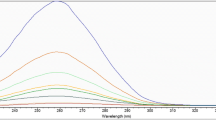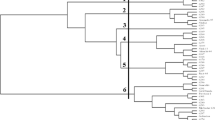Abstract
Ancient DNA (aDNA) from 3500–4000 years old seeds of Triticum aestivum L. or Triticum durum Dest., Vicia ervillia (L) Willd., Cicer arietinum L. and Vitis vinifera L. excavated from the archaeological site of Kaymakçı was successfully extracted using various isolation methods. The genomic DNA of each species was amplified with respect to the 26S ribosomal DNA (rDNA) gene further using the aDNA of the seeds. The reasons for successful DNA extraction and amplification are likely due to (1) preservation of certain ancient seed specimens in good conditions and (2) use of improved DNA extraction and amplification methods. The results indicate that all seeds were identified correctly by the DNA sequence data from the 26S rDNA gene. Specifically, a morphologically unidentified wheat seed from Kaymakçı was characterized by DNA sequence data as bread wheat (Triticum aestivum). Comparative sequence analysis revealed that specific base positions in the ancient 26S rDNA gene were either lost or substituted with different DNA bases in contemporary seeds, most likely due to continued domestication and breeding activities. Attaining high amounts and a good quality of amplified genomic DNA from ancient seeds will further allow the investigation of the extent of genetic change between ancient seeds and their contemporary species in genetic diversity studies.







Similar content being viewed by others
References
Allaby RG, Jones MK, Brown TA (1994) DNA in charred wheat grains from the Iron Age hillfort at Danebury, England. Antiquity 68(258):126–132
Allaby RG, O’donogue K, Sallares R, Jones MK, Brown TA (1997) Evidence for survival of ancient DNA in charred wheat seeds frım European archaeological sites. Anc Biomol 12:119-129
Altschul SF, Gish W, Miller W, Myers EW, Lipman DJ (1990) Basic local alignment search tool. J Mol Biol 215(3):403–410
Alvarez I, Wendel JF (2003) Ribosomal ITS sequences and plant phylogenetic inference. Mol Phylogenet Evolut 29(3):417–434
Baer CF (2008) Does mutation rate depend on itself? PLoS Biol 6(2):e52
Barraclough TG, Savolainen V (2001) Evolutionary rates and species diversity in flowering plants. Evolution 55:677–683
Bilgiç H, Hakki EE, Pandey A, Khan MK, Akkaya MS (2016) Ancient DNA from 8400 year-old Çatalhöyük wheat: implications for the origin of Neolithic agriculture. PLoS ONE 11(3):e0151974
Brown TA (1999) How ancient DNA may help in understanding the origin and spread of agriculture. Philos Trans R Soc Lond B 354:89–98
Brown TA, Jones MK, Powell W, Allaby RG (2008) The complex origins of domesticated crops in the fertile crescent. Trends Ecol Evolut 24(2):103–109
Bryce TR (2005) The Kingdom of the Hittites, New edn. Oxford University Press, Oxford
Bunning SL, Jones G, Brown TA (2012) Next generation sequencing of DNA in 3300-year-old charred cereal grains. J Archaeol Sci 39:2780–2784
Cappellini E, Gilbert MTP, Geuna F, Fiorentino G, Hall A, Thomas-Oates J, Ashton PD, Ashford DA, Arthur P, Campos PF, Kool J, Willerslev E, Collins MJ (2010) A multidisciplinary study of archaeological grape seeds. Naturwissenschaften 97:205–217. https://doi.org/10.1007/s00114-009-0629-3
Deguilloux MF, Pemonge MH, Bertel L, Kremer A, Petit RJ (2003) Checking the geographical origin of oak wood: molecular and statistical tools. Mol Ecol 12:1629–1636. https://doi.org/10.1046/j.1365-294X.2003.01836.x
Duchene D, Bromham L (2013) Rates of molecular evolution and diversification in plants: chloroplast substitution rates correlate with species-richness in the Proteaceae. BMC Evolut Biol 13:65. https://doi.org/10.1186/1471-2148-13-65
Fairbairn A, Martinoli D, Butler A, Hillman G (2007) Wild plant seed storage at Neolithic Çatalhöyük East, Turkey. Veg Hist Archaeobot 16(6):467–479
Gugerli F, Parducci L, Petit RJ (2005) Ancient plant DNA: review and prospects. New Phytol 166(2):409–418
Hawkins JD (1998) Tarkasnawa, King of Mira: ‘Tarkondemos’, Boğazköy Sealings and Karabel. Anatol Stud 48:1–31
Jovanovic Z, Stanisavljevic N, Nikolic A, Medovic A, Mikic A, Radovic S, Dordevic V (2011) Pisum & ervilia Tetovac—made in early iron age Leskovac, part two: extraction of the ancient DNA from charred seeds from the site of Hissar in South Serbia. Ratar Povrt 48:227–232
Kılınç GM et al (2016) The demographic development of the first farmers in Anatolia. Curr Biol 26(19):2659–2666
Kistler L (2012) Ancient DNA extraction from plants. Methods Mol Biol 840:71–79. https://doi.org/10.1007/978-1-61779-516-9_10
Kumar S, Stecher G, Li M, Knyaz C, Tamura K (2018) MEGA X: molecular evolutionary genetics analysis across computing platforms. Mol Biol Evol 35(6):1547–1549. https://doi.org/10.1093/molbev/msy096
Kuzoff RK, Sweere JA, Soltis DE, Soltis PS, Zimme EA (1998) The phylogenetic potential of entire 26S rDNA sequences in plants. Mol Biol Evolut 15(3):251–263
Li C, Lister DL, Li H, Xu Y, Cui Y, Bower MA, Jones MK, Zhou H (2011) Ancient DNA analysis of desiccated wheat grains excavated from a bronze age cemetery in Xinjiang. J Archaeol Sci 38(1):115–119
Lister DL, Bower MA, Howe CJ, Jones MK (2008) Extraction and amplification of nuclear DNA from herbarium specimens of emmer wheat, amethod for assessing DNA preservation by maximum amplicon length recovery. Taxon 57:254–258
Luke C, Roosevelt CH (2017) Cup-marks and citadels: evidence for libation in the second-millennium BCE Marmara Lake Basin, Western Anatolia. Bull Am Sch Orient Res 378:1–23
Luke C, Roosevelt CH, Cobb P, Çilingiroğlu Ç (2015) Composing communities: chalcolithic through iron age survey ceramics in the Marmara lake basin, Western Turkey. J Field Archaeol 40(4):428–449
Mascher M, Schuenemann VJ, Davidovich U, Marom N, Himmelbach A, Hübner S, Korol A, David M, Reiter E, Riehl S, Schreiber M, Vohr SH, Green RE, Dawson IK, Russell J, Kilian B, Muehlbauer GJ, Waugh R, Fahima T, Krause J, Weiss E, Stein N (2016) Genomic analysis of 6000-year-old cultivated grain illuminates the domestication history of barley. Nat Genet 48(9):1089–1093. https://doi.org/10.1038/ng.3611
Medovic A, Mikic A, Cupina B, Jovanovic Z, Radovic S, Nikolic A et al (2011) Pisum and ervilia tetovac—made in early iron age leskovac, part one: two charred pulse crop storages of the fortified hill fort settlement Hissar in Leskovac, South Serbia. Ratar Povrt 48(1):219–226. https://doi.org/10.5937/ratpov1101219M
Mikic A (2016) Presence of vetches (Vicia spp) in agricultural and wild floras of ancient Europe. Genet Resour Crop Evol 63:745. https://doi.org/10.1007/s10722-016-0382-3
Mikic A, Medovic A, Jovanovic Z, Stanisavljevic N (2015) A note on the earliest distribution, cultivation and genetic changes in bitter vetch (Vicia ervilia) in ancient Europe. Genetika 47(1):1–11
Nasab HM, Mardi M, Talaee H, Nashli HF, Pirseyedi SM, Noubari AH, Mowla SJ (2010) Molecular analysis of ancient DNA extracted from 3250–3450-year-old plant seeds excavated from Tepe Sagz Abad in Iran. J Agric Sci Technol 12:459–470
Nistelberger HM, Smith O, Wales N, Star B, Boessenkool S (2016) The efficacy of high-throughput sequencing and target enrichment on charred archaeobotanical remains. Sci Rep 6:37347. https://doi.org/10.1038/srep37347
Oliveira HR, Civá P, Morales J, Rodríguez-Rodríguez A, Lister DL, Jones MK (2012) Ancient DNA in archaeological wheat grains: preservation conditions and the study of pre-Hispanic agriculture on the island of Gran Canaria (Spain). J Archaeol Sci 39:828–835
Özgen M, Özdilek A, Birsin MA, Önde S, Şahin D, Acıkgoz E, Kaya Z (2012) Analysis of ancient DNA from in vitro grown tissues of 1600-year-old seeds revealed the species as Anagyris foetida. Seed Sci Res 22(4):279–286
Paabo S, Poinar H, Serre D, Jaenicke-Despres V, Hebler J, Rohland N, Kuch M, Krause J, Vigilant L, Hofreiter M (2004) Genetic analyses from ancient DNA. Annu Rev Genet 38:645–647
Palmer SA, Clapham AJ, Rose P, Freitas FO, Owen BD, Beresford-Jones D et al (2012) Archaeogenomic evidence of punctuated genome evolution in gossypium. Mol Biol Evol 29:2031–2038. https://doi.org/10.1093/molbev/mss070
Parducci L, Rémy P (2004) Ancient DNA - Unlocking plants’ fossil secrets. New Phytol 161(2):335–339
Rogers SO, Kaya Z (2006) DNA from ancient cedar wood from King Midas Tomb, Turkey, and Al-Aksa Mosque, Israel. Silvae Genet 55(1–6):54–62
Rogers SO, Theraisnathan V, Ma LJ, Zhao Y, Zhang G, Shin S-G, Castello JD, Starmer WT (2004) Comparisons of protocols to decontaminate environmental ice samples for biological and molecular examinations. Appl Environ Microbiol 70(4):2540–2544
Roosevelt CH, Luke C (2017) The story of a forgotten kingdom? Survey archaeology and the historical geography of Central Western Anatolia in the second millennium BC. Eur J Archaeol 20(1):120–147
Roosevelt CH, Cobb P, Moss E, Olson BR, Ünlüsoy S (2015) Excavation is destruction digitization: advances in archaeological practice. J Field Archaeol 40(3):325–346
Roosevelt CH, Luke C, Ünlüsoy C, Çakırlar C, Marston JM, O’Grady CR, Pavuk P, Pieniążek M, Mokrisova J, Scott C, Shin N, Slim F (2018) Exploring Space, Economy, and Interregional Interaction at a Second-Millennium BCE citadel in Central Western Anatolia: 2014–2017 Research at Kaymakçı. Am J Archaeol 122(4):645–688
Sadori L, Susanna F, Persiani C (2006) Archaeobotanical data and crop storage evidence from an early bronze age 2 burnt house at Arslantepe, Malatya, Turkey. Veg Hist Archaeobot 15(3):205–215
Schlumbaum A, Tensen M, Jaenicke-Després V (2008) Ancient plant DNA in archaeobotany. Veget Hist Archaeobot 17:233. https://doi.org/10.1007/s00334-007-0125-7
Shin N, Luke C, Marston JM, Roosevelt CH, Riehl S (in review) Applying archaeobotanical and geospatial analysis to identify patterns of plant use and risk-management strategies at Bronze Age Kaymakçı, Western Anatolia. Vegetation History and Archaeobotany
Smith SA, Donoghue MJ (2008) Rates of molecular evolution are linked to life history in flowering plants. Science 322(5898):86–89
Smykal P, Jovanovic Z, Stanisavljevic N et al (2014) A comparative study of ancient DNA isolated from charred pea (Pisum sativum L.) seeds from an Early Iron Age settlement in southeast Serbia: inference for pea domestication. Genet Resour Crop Evol 61:1533. https://doi.org/10.1007/s10722-014-0128-z
Tani N, Tsumura Y, Sato H (2003) Nuclear gene sequences and DNA variation of Cryptomeria japonicasamples from the postglacial period. Mol Ecol 12(4):859–868
Thompson JD, Higgins DG, Gibson TJ (1994) CLUSTAL W: improving the sensitivity of progressive multiple sequence alignment through sequence weighting, position-specific gap penalties and weight matrix choice. Nucl Acids Res 22(22):4673–4680
Author information
Authors and Affiliations
Corresponding authors
Ethics declarations
Conflict of interest
No known or potential conflicts of interest exist for any author.
Additional information
Publisher's Note
Springer Nature remains neutral with regard to jurisdictional claims in published maps and institutional affiliations.
Zeki Kaya: Corresponding author for the ancient DNA. Christina Luke: corresponding author for the archaeological aspects of the study.
Rights and permissions
About this article
Cite this article
Ciftci, A., Değirmenci, F.O., Luke, C. et al. Ancient DNA (aDNA) extraction and amplification from 3500-year-old charred economic crop seeds from Kaymakçı in Western Turkey: comparative sequence analysis using the 26S rDNA gene. Genet Resour Crop Evol 66, 1279–1294 (2019). https://doi.org/10.1007/s10722-019-00783-9
Received:
Accepted:
Published:
Issue Date:
DOI: https://doi.org/10.1007/s10722-019-00783-9




